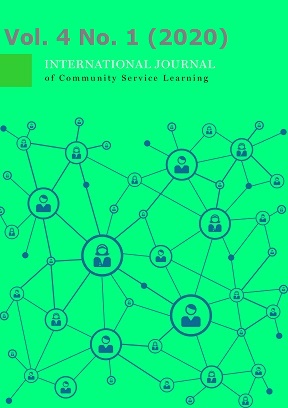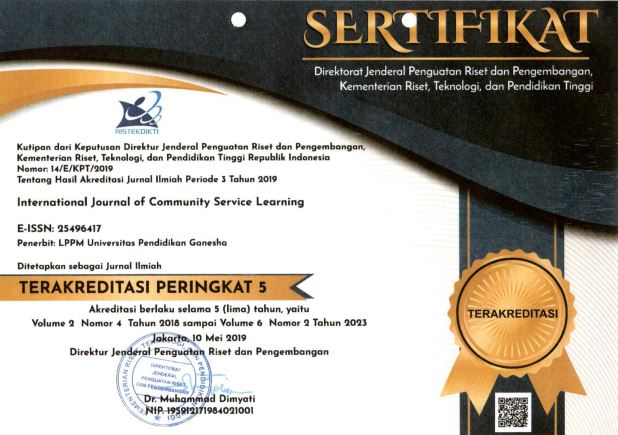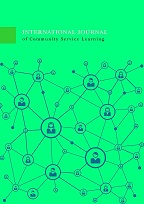“Leave No One Behind” in Education: Empowering Vulnerable Youth towards Self-Sustainability and Social Development
DOI:
https://doi.org/10.23887/ijcsl.v4i1.23197Abstrak
Every human being has equal right to obtain proper education which prospectively promotes decent employment and life prosperity. Vulnerable children and youth are potential human resources who should be encouraged to develop themselves and meaningfully contribute to society. This study aims to explore education service and learning for encouraging orphanage youth at Panti Asuhan BJ Habibie-Surabaya to be self-sustained and potentially contributes to society. Qualitative method is adopted to meet research objectives. The data are collected through direct participant observation in a community service. The study indicates that life skill education promotes life values which support the orphans to face life challenges. Being able to be self-educated, developed and discover positive life meaning can be potential investment for the orphans to survive. The growth of contributing and meaningful vulnerable youth requires a caring society who provides just and encouraging climate for the vulnerable to learn, develop and promote intergenerational learning.Referensi
Alcantara, A. L. F. (2018). Vulnerable Youth: Background and Policies (No. RL33975; pp. 1–63). Retrieved from Congressional Research Service website: www.crs.gov
Arora, S. K., Shah, D., Chaturvedi, S., & Gupta, P. (2015). Defining and Measuring Vulnerability in Young People. Indian Journal of Community Medicine, 40(3), 193–197. https://doi.org/doi: 10.4103/0970-0218.158868
Atchoarena, D. (2019). Implement lifelong learning for sustainable development (pp. 1–27). Retrieved from UNESCO Institute for Lifelong Learning website: http://unesco.org/uil
Bankoff, G. (2003). Vulnerability as a measure of change in society. International Journal of Mass Emergencies and Disasters, 21(2), 5–30.
Boomkens, C., Metz, J. W., Schalk, R. M. J. D., & Van Regenmortel, T. M. R. F. (2019). The role of social environment in acquiring agency in Girls Work. Children and Youth Services Review, 104(104399), 1–9. https://doi.org/10.1016/j.childyouth.2019.104399
Butler, E. P., Taggart, N., & Chervin, N. (2012). Education, Earning, and Engagement for Out-of-School Youth in 26 Developing Countries: What Has Been Learned from Nine Years of EQUIP3? Journal of International Cooperation in Education, 15(2), 129–158.
Chen, S.-H. (Ava), Nasongkhla, J., & Donaldson, J. A. (2015). University Social Responsibility (USR): Identifying an Ethical Foundation within Higher Education Institutions. TOJET: The Turkish Online Journal of Educational Technology, 14(4), 165–172.
Claude, R. P. (2005). The right to education and human rights education. International Journal on Human Rights, 2(2), 37–59.
Coomans, F. (2002). Exploring the normative content of the right to education as a human right: Recent approaches. In Core Obligations: Building a Framework Jor Economic, Social and Cultural Rights (pp. 217–246). Antwerp: Intersentia.
Crowther, D., & Aras, G. (2008). Corporate social responsibility. Ventus Publishing ApS.
Dima, G., Resch, K., Borcos, A., & Janžekovič, P. (2016). From Corporate Social Responsibility (CSR) to University’s Social Responsibility (USR): a reader (Technical Report No. 2015–201; p. DOI: 10.13140/RG.2.2.24751.43686). Retrieved from www.postgraduatecenter.at/unibility
Duffy, V., Hayden, I., & O’Brien, D. (2017). Peace and Justice: It’s up to Youth (pp. 2–50) [Resource Pack]. Ireland: National Youth Council of Ireland and NYCI Development Education Programme.
Emas, R. (2015). The Concept of Sustainable Development: Definition and Defining Principles (pp. 1–3).
English, L. M., & Carlsen, A. (2019). Lifelong learning and the Sustainable Development Goals (SDGs): Probing the implications and the efects. International Review of Education, 65, 205–211. https://doi.org/10.1007/s11159-019-09773-6
Esfijani, A., Hussain, F., & Chang, E. (2013). University social responsibility ontology. Engineering Intelligent Systems, 21(4), 271–281.
EU USR. (2015). Comparative Research on the Social Responsibility of Universities in Europe and Development of a Community Reference Framework (No. 52709-LLP-2012-1-RO-ERASMUS-ESIN; pp. 1–23). Retrieved from EU USR website: http://www.eu-usr.eu/
Glenn, E. N. (2000). Creating a caring society. Contemporary Sociology, 29(1), 84–94.
Gorur, R. (2015). Vulnerability: Construct, complexity and consequences. In Interrogating Conceptions of “Vulnerable Youth” in Theory, Policy and Practice (pp. 3–15). Retrieved from https://www.sensepublishers.com/
Government of South Australia. (n.d.). Working with Vulnerable Youth Key Concepts and Principles. Retrieved from Office for Youth Department for Communities and Social Inclusion website: www.officeforyouth.sa.gov.au
Hoelman, M. B., Parhusip, B. T. P., Eko, S., Bahagijo, S., & Santono, H. (2016). Sustainable development goals-SDGs. Panduan Untuk Pemerintah Daerah (Kota dan Kabupaten) dan Pemangku Kepentingan Daerah (pp. 3–74). Jakarta: International NGO Forum on Indonesian Development (INFID).
Huijser, H., Bedford, T., & Bull, D. (2008). Open Course Ware, Global Access and the Right to Education: Real access or marketing ploy? International Review of Research in Open and Distance Learning, 9(1), 1–13.
Iwuchukwu, J. C., Ogbonna, O. I., & Agboti, I. O. (2015). Roles of youths groups in rural community development in Ebonyi State, Nigeria. Journal of Agricultural Extension and Rural Development, 7(2), 41–47. https://doi.org/DOI: 10.5897/JAERD2014. 0639
Jokowali, G., Wicaksono, B. T., & Rosyadi, I. (n.d.). Upaya memosisikan bahasa di dalam masyarakat multilingualisme era mutakhir abad ke-21. Presented at the Presented at the Kongres Bahasa Indonesia.
KPMG. (2017). Lifelong Learning. Creating the Change We Need for the World We Want (pp. 1–26). Retrieved from KPMG International Cooperative website: kpmg.com/uk
Lee, S. E. (n.d.). Education as a Human Right in the 21st Century. Democracy & Education, 21(1), 1–9.
Lohrenscheit, C. (2002). International Approaches in Human Rights Education. International Review of Education, 48(3–4), 173–185.
ManpowerGroup. (2012). How Policymakers Can Boost Youth Employment (pp. 1–45). Retrieved from ManpowerGroup website: www.manpowergroup.com
Manuel, M., Grandi, F., Manea, S., Kirbyshire, A., & Lovell, E. (2018). ‘Leave no one behind’ index 2018. Retrieved from odi.or
Ministry of National Development Planning/, & National Development Planning Agency. (n.d.). Roadmap of SDGs Indonesia: A Highlight (pp. 1–114). Retrieved from Indonesian Secretariat for Sustainable Development Goals, Ministry of National Development Planning/National Development Planning Agency, Indonesia website: sdgs.bappenas.go.id
Moretti, G. A. S., & Frandell, T. (2013). Literacy from a Right to Education Perspective (The Director-General of the United Nations Educational, Scientific and Cultural Organization to Be Submitted to the UN General Assembly at Its 68th Session No. ED/2013/BLS/BAS/PI/1; pp. 1–23). UNESCO.
Nucci, L. P., & Narvaez, D. (2008). Handbook of Moral and Character Education. New York: Routledge.
Robeyns, I. (2006). Three models of education: rights, capabilities and human capital. In Press. In Theory and Research in Education (Vol. 4, Issue. 1, pp. 69–84). Retrieved from www.sagepublications.com
Sarker, C., & Hossain, M. M. (2019). Role of youth organisations in the development of Bangladesh. BRAC Advocacy for Social Change.
Schuster, K. R., & Pritzker, S. (2015). Strengthening youth participation in civic engagement: Applying the Convention on the Rights of the Child to social work practice. Children and Youth Services Review, 57, 90–97. http://dx.doi.org/10.1016/j.childyouth.2015.07.013
Search for Common Ground. (2018). Youth Impact in Shaping Policy & Social Cohesion in Myanmar (pp. 2–14). Search for common ground.
Stop Hunger Foundation, & No Kid Hungry. (n.d.). Youth Engagement Toolkit. Retrieved from www.NoKidHungry.org/YouthToolkit
Strand, K., Marullo, S., Cutforth, N. J., Stoecker, R., & Donohue, P. (2003). Principles of Best Practice for Community-Based Research. Michigan Journal of Community Service Learning, 9(3), 5–15.
Swick, K. J. (2006). Families and Educators Together: Raising Caring and Peaceable Children. Early Childhood Education Journal, 33(4), 279–287. https://doi.org/DOI: 10.1007/s10643-005-0033-3
The Inter-Parliamentary Union, & The United Nations (Office of the High Commissioner for Human Rights). (2016). Human Rights. Handbook for Parliamentarians No 26. Retrieved from www.ipu.org; www.ohchr.org
The World Bank. (2006). Development and the Next Generation (World Development Report No. 35999; pp. 1–305). Washington, D.C.: The International Bank for Reconstruction and Development / The World Bank.
Tomasevski, K. (2003). Education Denied. London and New York: Zed Books.
Torjman, S. (1998). Strategies for a Caring Society. 1–22. Retrieved from www.caledoninst.org
Trucco, D., & Ullmann, H. (2016). Youth: realities and challenges for achieving development with equality. Santiago: Economic Commission for Latin America and the Caribbean (ECLAC).
UNDP. (2014). UNDP Youth Strategy 2014-2017. Empowered Youth, Sustainable Future (pp. 1–50). New York: United Nations’ Development Programme.
UNDP. (2018). What does it mean to leave no one behind? A UNDP discussion paper and framework for implementation. the United Nations Development Programme (UNDP) Bureau for Policy and Programme Support.
UNDP. (2019). SDGs in Indonesia: 2018 and beyond. Retrieved from Indonesia website: https://www.id.undp.org/content/indonesia/en/home/presscenter/articles/2018/sdgs-in-indonesia--2018-and-beyond.html
UNDP. (n.d.). Sustainable Development Goals. Retrieved from https://www.undp.org/content/dam/undp/library/corporate/brochure/SDGs_Booklet_Web_En.pdf
UNESCO. (2000a). The Dakar framework for action: Education for all: Meeting our collective commitments (including six regional framework for meeting) (Programme and Meeting Document No. ED.2000/WS/27; pp. 1–77). Retrieved from UNESCO website: www.unesco.org
UNESCO. (2000b). The right to education: towards education for all throughout life (pp. 9–173) [World education report 2000]. UNESCO Publishing.
UNESCO. (2005). Report of the Inter-Agency Working Group on Life Skills in EFA (Programme and Meeting Document No. ED/PEQ/IQL/2005/RP/H/1; pp. 1–14). Retrieved from https://unesdoc.unesco.org/ark:/48223/pf0000141012?posInSet=1&queryId=a7e4ee4f-9e40-49fc-aefd-227397411a28
UNESCO. (2015). Contributing to a more sustainable future: quality education, life skills and education for sustainable development (Programme and Meeting Document No. ED/PEQ/IQL/2005/PI/H/2; pp. 1–8). Retrieved from UNESCO website: http://www.unesco.org/education
UNESCO. (n.d.). Education transforms lives (Programme and Meeting Document No. ED.2017/WS/3). Retrieved from UNESCO Education Sector website: www.unesco.org/education www.facebook.com/unesco @UNESCO www.youtube.com/unesco www.linkedin.com/company/unesco (join UNESCO’s Group on Education) plus.google.com/+UNESCO/posts
UNICEF. (2007). A Human Rights-Based Approach to Education for all. A framework for the realization of children’s right to education and rights within education. Retrieved from ISBN. ISBN: 978-92-806-4188-2
Unicef. (2012). Global evaluation of lifeskills education programmes (pp. 1–148) [Evaluation Report]. Retrieved from Evaluation Office website: evalhelp@unicef.org
Unicef. (2017). Reimagining Life Skills and Citizenship Education in the Middle East and North Africa A Four-Dimensional and Systems Approach to 21st Century Skills. Conceptual and Programmatic Framework (pp. 1–167). Jordan: UNICEF MENA Regional Office.
Unicef. (n.d.-a). Introduction. Retrieved from unicef-for every child website: https://www.unicef.org/lifeskills/
Unicef. (n.d.-b). Life Skills for Young Ugandans-Secondary Teachers’ Training Manual. Retrieved from http://www.nzdl.org/
United Nations. (2017). The Sustainable Development Goals Report (pp. 2–60). Retrieved from United Nations website: ISBN 978-92-1-101368-9
United Nations. (2018). Youth and the 2030 agenda for sustainable development (pp. 1–210). New York: United Nations.
United Nations. (n.d.). Transforming our World: The 2030 Agenda for Sustainable Development (No. A/RES/70/1; pp. 3–36). Retrieved from United Nations website: sustainabledevelopment.un.org
United Nations-Indonesia. (n.d.). Sustainable Development Goals (SDGs). Retrieved from https://www.un.or.id/what-we-do/sustainable-development-goals-sdgs
Vallaeys, F. (n.d.). University social responsiblity: A mature and responsible definition. Retrieved from http://www.guninetwork.org/
Wade, R. C. (1995). Developing Active Citizens: Community Service Learning in Social Studies Teacher Education. Service Learning , General. Paper 36. Retrieved from http://digitalcommons.unomaha.edu/slceslgen/36
Ward, K., & Wolf-Wendel, L. (2000). Community-centered service learning. Moving from doing for to doing with. The American Behavioral Scientist, 43(5), 767–780.
Webb, S., Holford, J., Hodge, S., Milana, M., & Waller, R. (2019). Conceptualising lifelong learning for sustainable development and education 2030. International Journal of Lifelong Education, 38(3), 237–240. https://doi.org/DOI: 10.1080/02601370.2019.1635353
World Health Organization. (1999). Partners in Life Skills Education. Conclusions from a United Nations Inter-Agency Meeting (No. WHO/MNH/MHP/99.2; pp. 1–13). Geneva: Department of Mental Health World Health Organization.
Unduhan
Diterbitkan
Cara Mengutip
Terbitan
Bagian
Lisensi

International Journal of Comunnity Service Learning is licensed under a Creative Commons Attribution-ShareAlike 4.0 International License.













